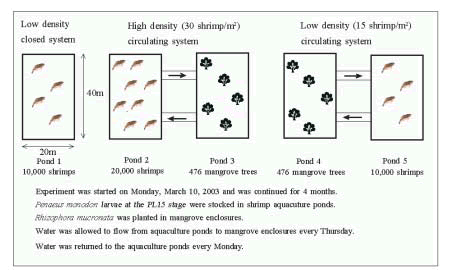Elucidation of natural purification capabilities in mangrove ecosystems
Description
[Objectives]
In order to develop an environment-friendly aquaculture system utilizing the natural purification capabilities and high productivity of mangrove brackish waters, water was circulated between aquaculture ponds and mangrove enclosures. The continuous flow of water from aquaculture ponds maintained water and mud quality, while aquaculture ponds received plankton-rich water from the mangrove enclosures (Fig. 1).
[Results]
Survival rate was highest, and the feed conversion ratio (quantity of feed per unit weight increase) was lowest in Pond 5, in which larvae were stocked at low density, and the water was exchanged with mangrove water. Thus, Pond 5 achieved the most efficient level of aquacultural production.
In Pond 1, P content in the mud exceeded the amount provided in the feed (Table 1) and the P budget for Pond 1 was negative. This suggests that extra P was supplied from another source. We believe that anoxia was responsible for the release of P from the lower depths of the ponds. In Pond 2, the budget results suggest that 1.55 kg of P flowed into the mangrove-planted pond. Although the budget results were negative in Pond 5, it was higher than that of Pond 1. If the same quantity of P in Pond 1 had been supplied in Pond 5 from the lower depths of the pond, about 0.43 kg of P should have flowed into the mangrove ecosystem. As a result, deterioration in the lower pond environment was reduced in Ponds 2 and 5 via the circulation of water between the shrimp and mangrove ponds, in comparison to the control. Because the P budget was higher in Ponds 2 and 5 relative to the control, environmental burden in the ponds was reduced.
Figure, table
-
Fig. 1. Outline of the water exchange experiment. -
Table 1. Phosphorus budget in each shrimp pond.;
- Affiliation
-
Japan International Research Center for Agricultural Sciences Fisheries Division
- Classification
-
Technical A
- Term of research
-
FY2003 (FY2001-2003)
- Responsible researcher
-
SHIMODA Toru ( Fisheries Division )
SRITHONG Chumpol ( Kasetsart University )
ARYUTHAKA Chittima ( Kasetsart University )
- ほか
- Publication, etc.
-
Shimoda, T., Srithong, C. and Aryuthaka, C. (2005): Attempt at purification of effluent and sediment in shrimp aquaculture ponds using mangrove Trees. JARQ, 39(2) (in press).
Attempt at Purification of Effluent and Sediment in Shrimp Aquaculture Ponds Using Mangrove Trees
Shimoda, T., Srithong, C. and Aryuthaka, C. (2004): Phosphorus budget in mangrove woods and ecosystems to which are added artificial nutrients and wastewater from the shrimp aquaculture ponds. JIRCAS working report, No. 35, 95-102.
Sustainable Production Systems of Aquatic Animals in Brackish Mangrove Areas
Shimoda, T., Srithong, C. and Aryuthaka, C. (2004): Attempt at purification of wastewater from shrimp aquaculture using mangroves. Abstract Volume of Spring Meeting of Oceanographic Society of Japan, 307 (in Japanese).
- Japanese PDF
-
2003_27_A3_ja.pdf2.17 MB
- English PDF
-
2003_27_A4_en.pdf59.91 KB


